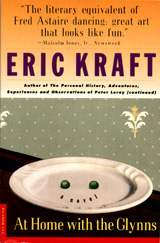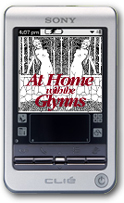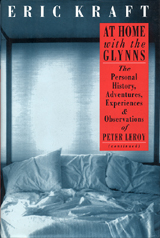
YOU CAN READ
THE FIRST HALF OF
THE BOOK
(21 CHAPTERS)
HERE,
ONLINE,
OR,
FOR MAXIMUM PORTABILITY
AND CONVENIENCE
WHEN READING
ON THE BEACH
OR
IN THE TUB,
YOU CAN BUY THE
PICADOR USA
PAPERBACK EDITION AT
AMAZON.COM
OR
BARNES&NOBLE.COM
OR
YOU CAN DOWNLOAD
THE COMPLETE TEXT
AS AN
eBOOK
AND
READ IT ON A PDA.

|
Chapter 2
Rolling Peas
 NE
DAY I was in the cafeteria at the new junior high school, making my way
along the steam table in a line with the other scholars, collecting the
various components of my lunch: half a pint of milk in a waxed cardboard
container shaped like a cabin in the woods; two slices of white bread;
a square pat of butter on a square of white cardboard with the edges bent
up to make a little tray, with a square of thin translucent waxed paper
stuck to the top; one slice of roast beef as thick as a nickel, marbled
like a topographic map, gray as the sheet of cardboard around which Spotless
Cleaners folded my father’s Sunday shirts, with gravy; mashed potatoes,
also with gravy; and those Troubled Titan peas. A woman in a hair
net dished the peas out onto my plate lukewarm and wet. The pea water,
gray-green like the peas themselves, spread instantly, making an island
of the mashed potatoes, mingling with the gravy. NE
DAY I was in the cafeteria at the new junior high school, making my way
along the steam table in a line with the other scholars, collecting the
various components of my lunch: half a pint of milk in a waxed cardboard
container shaped like a cabin in the woods; two slices of white bread;
a square pat of butter on a square of white cardboard with the edges bent
up to make a little tray, with a square of thin translucent waxed paper
stuck to the top; one slice of roast beef as thick as a nickel, marbled
like a topographic map, gray as the sheet of cardboard around which Spotless
Cleaners folded my father’s Sunday shirts, with gravy; mashed potatoes,
also with gravy; and those Troubled Titan peas. A woman in a hair
net dished the peas out onto my plate lukewarm and wet. The pea water,
gray-green like the peas themselves, spread instantly, making an island
of the mashed potatoes, mingling with the gravy.
Of the many things that puzzled me about school,
one was that the common sense so prized in society at large in those days
never seemed to penetrate the doors of the school building. Watching
the pea water and the gravy interswirl, I wondered why the divided plates
that my family used on picnics were not used here in the school cafeteria,
where they were really needed. Finding myself wondering along those
lines, I thought of suggesting the use of divided plates to one of the
ladies in the hair nets, but I decided against it, because the time that
I’m recalling was a time when young people generally kept their mouths
shut.
(Years later, at Hargrove College, I walked into
the Student Union for my first meal and saw there a stack of circular divided
trays that combined the functions of tray and plate and kept the foods
and sauces apart from one another. I smiled with secret satisfaction,
because I knew now, for certain, that I was in the realm of the wise.
I was less certain a moment later, when, making my way along a steam table
larger than but otherwise terribly like the ones I had walked along in
the Babbington public schools, I was offered some of the same peas, which
I had hoped to have left behind forever.)
Occupied by my thoughts, I took a seat at a table
that was otherwise unoccupied and set my tray on the table. I was observing
the spread of the pea water when Margot and Martha Glynn arrived and sat
on either side of me, Margot on my right and Martha on my left.
“Are you right- or left-handed, Peter?” asked Margot
without preamble.
“Well,” I said, “I write with my right hand but
I throw a ball with my left, so you could say I’m—”
I paused slightly, because I enjoyed the word I
was about to say and was proud of the skill it summarized.
“—ambidextrous.”
“That’s good. Ambidextrous is good,” said
Margot.
“But those are useless skills,” said Martha.
“Yes,” said Margot. “Let me see you pat your
head and rub your stomach.”
I put my right hand on my head and my left on my
stomach and made a first, tentative attempt, such a slight attempt that
I didn’t think they would notice if I got it wrong. I was rubbing
both my head and my stomach. I made the necessary correction and
began patting my head with a simple up-and-down motion and rubbing my stomach,
also in a simple up-and-down motion, the two movements exactly parallel.
The girls exchanged glances.
“Rub your stomach back and forth instead of up and
down,” said Martha.
I shifted to that pretty easily, but in shifting
I began rubbing my head back and forth, too. It took me a moment
to recover. When I was again rubbing and patting, Margot said quickly,
“Now rub in a circular motion.”
It wasn’t easy. I got a little confused, but,
after some fumbling, I got the pat-and-rub going again.
“Change hands,” said Margot.
This wasn’t easy at all, but I managed it, and I
soon found that with practice the effort was becoming easier in general.
Perhaps it is true of all skills, however minor or useless, that once we
acquire some facility in them, we want to get past mere facility to something
that can do us some good, something that might make us stand out from our
peers, some showy display of skill, some flash. I began making changes
on my own, without waiting for Margot or Martha to demand them: reversing
the direction of my rubbing, patting in double time, switching hands at
unpredictable moments.
“Okay, okay,” said Margot. “Quit showing off.
What about rolling peas?”
“Rolling peas?” I had the feeling that a joke
was coming.
“Try it,” said Martha. She picked a pea from
her plate with the tip of her spoon and let it roll onto the table between
us. Margot did the same with one of hers.
“Now rest your finger on that pea,” said Margot.
“Martha’s, too.”
I put my index fingers on the peas.
“This one,” said Martha, taking the middle finger
of my hand and placing it on her pea. Margot made the same change
on her side.
“Just rest your finger there lightly,” Margot cautioned.
“Don’t squash the little thing.”
I did as she said.
“The same over here,” said Martha.
“Good,” said Margot. “Now let’s see you roll
the peas around a little.”
Cautiously, I began to move my fingers on the peas.
“Close your eyes,” said Martha.
I closed my eyes, and I found that that helped.
The peas seemed larger, more easily manipulated. I had a better sensation
of the feeling of each pea against the finger pad that rested on it.
I seemed to acquire a sense of the difference between the skin of the pea
and the mush it contained, to understand the tensile limits of the skin,
the edge of the danger of rupturing it, and the resistant resilience of
the ball of mush within. I became a little bolder, rolling the peas
a little farther, a little faster—and the right one got away from me.
“Don’t get cocky,” said Margot. “Just move
them around a little. Don’t try to impress us.”
“You’ve got to walk before you can fly,” said Martha.
“Try again.” Humbled, I moved the peas gingerly, maintaining control,
moving them ever so slightly, just keeping each pea on the central ridge
of my finger pad, never rolling so far that the pea would slip away.
“Now move them from side to side,” said Margot.
She had seen how conservative I was being. Carefully, I moved my
fingers from side to side, paying close attention to the contact of pea
and finger. I wasn’t going to let the little devils get away from
me.
“Now up and back.”
I had, extrapolating from my recent pat-your-head-and-rub-your-stomach
experience without being aware of it, expected something like this, anticipated
that the girls would suddenly, at unpredictable moments, throw challenges
like this one at me, so I was, somewhere below or beyond thought, ready
for them, and I was able to shift to an up-and-back stroke without getting
flustered.
“Concentrate, now,” said Margot. “Pay attention
to what you’re doing.”
“It’s going to get tricky,” said Martha.
“Okay.” I did concentrate, and I was intrigued
to find how much I felt when I concentrated, how well and fully I could
feel the pea against the pad of my finger, sense the topography of my finger,
the gross shape, with the elongated ridge, the sloping sides, the quarter
sphere at the tip—dangerous territory, where the pea was likely to skitter
away from me—but even more, to feel the ridges and furrows of my fingerprints
against the smooth skin of the pea.
“You know,” I said, “I can actually feel—”
“Faster over here,” said Margot.
“And slower over here,” said Martha, “but with longer
strokes.”
“Okay, let me see. I—oops—I—”
“He squashed mine,” said Martha. There was
in her voice a note that I wouldn’t have expected. I might have expected
her to be annoyed with me, or I might have expected her to be amused, but
she was—and this was unmistakable—disappointed.
“What do you think?” she asked Margot.
“He can do it if he concentrates,” she said.
“I really think he can.”
“I’m not too well coordinated,” I said, by way of
excusing myself. I remembered my attempts to roller-skate, to play
the piano with two hands, to juggle.
“I wouldn’t say that,” said Margot, and I could
tell from her tone that she actually meant it.
“Nor would I,” said Martha.
“You just need to work on it.”
“Practice at home.”
“Practice at home?” I asked.
“You have peas at home, don’t you?”
“Sure, but—” I had intended to say that I
wasn’t allowed to play with my food, but when I looked into Margot’s doubting,
inquisitive eyes, I saw that such an objection was inappropriate.
I looked at Martha and saw the same thing in her eyes.
“But?” she asked.
“Nothing,” I said. “Never mind. Sure.
I’ll practice at home. But—”
“But what?”
“Well—why?”
They looked at each other. They looked at
me.
“Just to please us,” said Martha.
|
 |





 Here
are a couple of swell ideas from Eric Kraft's vivacious publicist, Candi
Lee Manning:
Here
are a couple of swell ideas from Eric Kraft's vivacious publicist, Candi
Lee Manning: